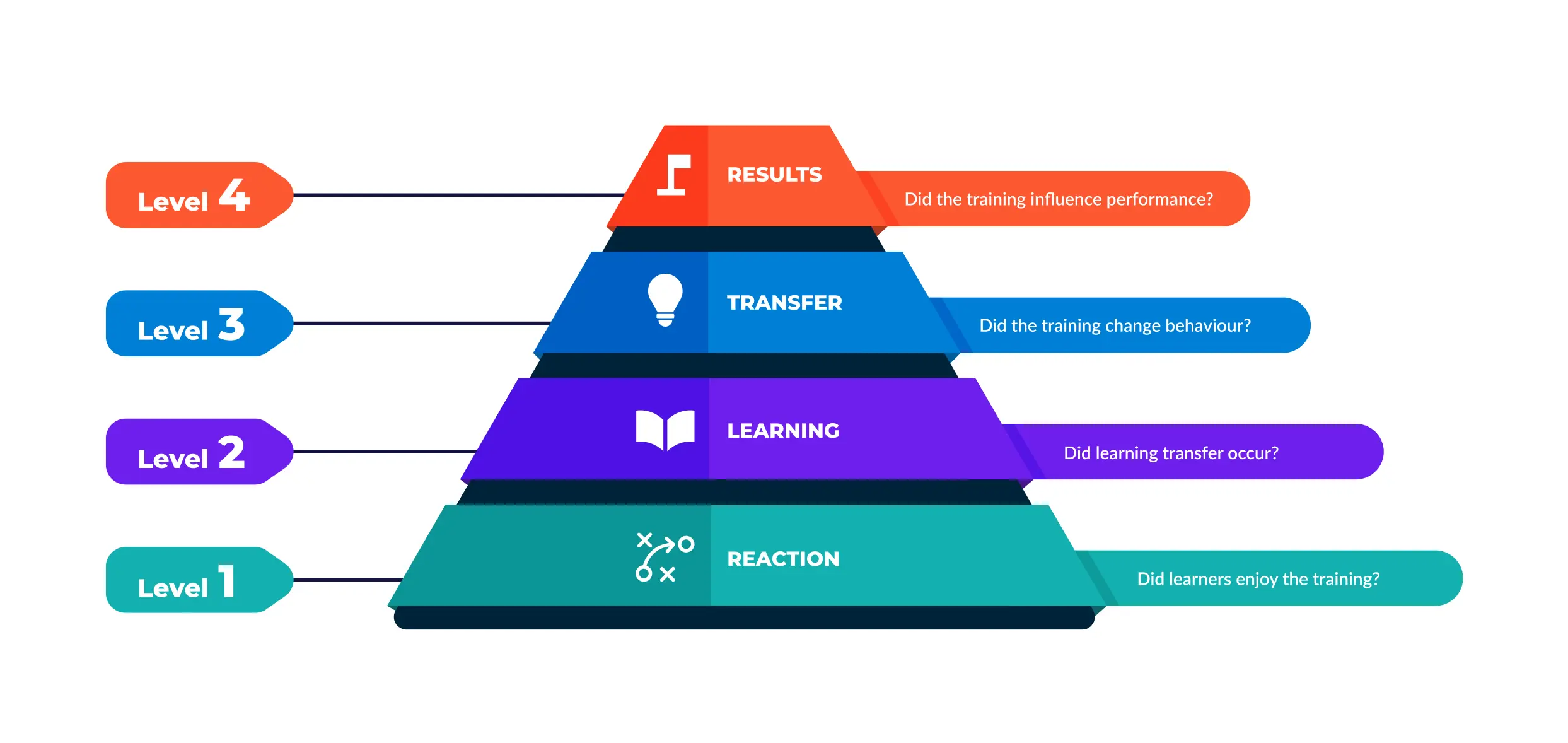In the realm of employee learning and development (L&D), meticulous preparation is paramount. L&D managers invest significant effort in carefully crafting training strategies, encompassing the identification of skill gaps, the establishment of learning objectives, the selection of appropriate training methodologies, program implementation, and continuous reinforcement of training. Yet, the ultimate litmus test for these elaborate training programs lies in their ability to deliver a return on investment (ROI), the application of acquired knowledge by participants, and their positive influence on job performance and overall organizational success.
However, gauging training effectiveness and extracting precise data to answer these crucial questions can be a formidable challenge for L&D teams. Traditional evaluation methods no longer suffice, prompting L&D professionals to seek innovative solutions to illuminate the impact of their training initiatives. One such solution that has gained global recognition and influence in corporate training evaluation is the Kirkpatrick Model.
In this article, we will delve into the Kirkpatrick Model’s four levels of training evaluation, exploring each level in detail and providing real-world examples to illustrate their practical applications.
What Is The Kirkpatrick Model?
The Kirkpatrick Model, developed by Dr. Donald Kirkpatrick and introduced through a series of articles published in 1959 is a widely recognized method for evaluating the effectiveness of training. It breaks down the evaluation process into four distinct levels: Reaction, Learning, Transfer, and Results. Each level provides a step-by-step framework to assess the impact of training from the initial participant reaction to the final results that affect the organization.
Understanding the Four Levels of Kirkpatrick Model:

1. Level 1: Evaluation – Reaction:

At the foundational level of the Kirkpatrick Model, we find the Reaction evaluation. This phase is primarily concerned with understanding how participants react to the training program. In essence, it measures their initial impressions, satisfaction, and overall perception of the training experience. While some may view this level as merely collecting feedback on the training’s presentation or ambiance, it serves a more profound purpose in the evaluation process.
To truly gauge the effectiveness of a training program, it is crucial to consider the learners’ emotional and cognitive responses. These reactions can provide valuable insights into the program’s initial engagement, relevance, and the level of buy-in from participants. It helps answer questions such as, “Did the participants find the content engaging and applicable to their roles?” or “Did they feel motivated to actively participate and learn?”
Examples of resources and techniques for Level 1 Reaction Evaluation:
- Post-training surveys: Administering surveys immediately after the training session can capture participants’ initial impressions. These surveys often include questions about the training’s content, presentation, and perceived value.
- Focus group discussions: In-depth discussions with a small group of participants can uncover qualitative insights into their reactions. This approach allows facilitators to delve deeper into participants’ thoughts and feelings about the training.
- Participant feedback forms: Simple feedback forms can be distributed at the end of each training session to gather quick input on various aspects of the training, including materials, trainers, and the overall experience.
- Online assessment that can be graded by delegates/evaluators.
Example of the Reaction level in practice:
Consider a scenario where a company has recently implemented a new customer service training program for its support team. After the initial training session, participants were asked to complete a satisfaction survey. The survey revealed that the majority of participants rated the training as highly engaging and applicable to their roles. Many commented on the practicality of the examples provided, which resonated with their daily work challenges. This positive reaction not only indicates that the training program had a strong start but also suggests that participants are likely to be more motivated to continue with the program.
In summary, Level 1 Reaction Evaluation goes beyond surface-level feedback and serves as the foundation for understanding participants’ initial engagement and satisfaction with the training. It helps L&D teams gauge the program’s relevance and sets the stage for deeper evaluations in subsequent Kirkpatrick Model levels. By collecting and analyzing these reactions, organizations can fine-tune their training programs to ensure they resonate with their target audience and set the stage for more substantial learning outcomes.
2. Level 2: Evaluation – Learning:

Moving beyond the initial reaction assessment, Level 2 of the Kirkpatrick Model delves into the crucial realm of learning. At this stage, the focus shifts from participants’ immediate impressions to evaluating what they have actually learned during the training. This level seeks to measure the acquisition of knowledge, skills, and competencies, ensuring that the training has effectively conveyed the intended learning outcomes.
Assessing learning is fundamental because it forms the bedrock upon which subsequent levels of evaluation are built. Without concrete evidence of learning, it becomes challenging to determine if the training has imparted the necessary skills and knowledge required for improved job performance. Level 2 evaluation serves as a critical bridge between the initial reactions and the practical application of acquired knowledge in the workplace.
Examples of tools and procedures for Level 2 Learning Evaluation:
- Pre-and post-training assessments: Conducting assessments both before and after the training program allows for a direct comparison of participants’ knowledge and skills. This method highlights the extent of learning that has taken place during the training.
- Knowledge quizzes: Administering quizzes that test participants on the specific content covered in the training provides quantitative data on their knowledge retention and comprehension.
- Skill demonstrations: In certain training programs, particularly those involving practical skills or procedures, participants may be required to demonstrate their newly acquired skills in a controlled environment.
Example of the Learning level in practice:
Continuing with the example of the customer service training program, participants were given a pre-training assessment to gauge their baseline knowledge of customer service best practices. Following the completion of the training, a post-training assessment was conducted to measure their understanding and retention of the material. The results showed a significant improvement in participants’ scores, with a notable increase in correct answers and a deeper understanding of key concepts. Furthermore, participants who had struggled with certain concepts in the pre-assessment demonstrated proficiency in those areas after the training. This tangible evidence of learning underscores the effectiveness of the training program in achieving its learning objectives.
In summary, Level 2 Learning Evaluation plays a pivotal role in the Kirkpatrick Model by providing empirical data on participants’ knowledge and skill acquisition. This level serves as a vital stepping stone toward assessing the practical application of these newfound abilities in the workplace, as explored in Level 3. By accurately measuring learning outcomes, organizations can make informed decisions about the effectiveness of their training programs and identify areas for improvement to ensure that participants are equipped with the necessary skills to excel in their roles.
3. Level 3: Evaluation – Transfer:

As we progress through the Kirkpatrick Model, we reach Level 3, which centers on evaluating the transfer of learning from the training environment to the actual workplace. This level is of paramount importance as it assesses whether the knowledge and skills acquired during the training program are being effectively applied on the job. In essence, it seeks to bridge the gap between training and real-world application.
The ultimate goal of any training initiative is to see a positive impact on job performance and organizational outcomes. Level 3 evaluation addresses the question: “Are participants taking what they’ve learned and successfully applying it in their day-to-day tasks?” Understanding the transfer of learning is crucial because it not only validates the training’s effectiveness but also measures its practical relevance and application.
Examples of assessment resources and techniques for Level 3 Transfer Evaluation:
- On-the-job observations: Trainers or supervisors can observe participants in their work settings to assess whether they are utilizing the knowledge and skills acquired during training in their daily tasks.
- Manager feedback: Managers can provide feedback and evaluations on their team members’ performance, specifically noting improvements or changes after training.
- Post-training surveys (follow-up): Surveys conducted weeks or months after the training program can gauge participants’ self-reported application of training concepts in their roles.
Real Example of the Transfer level in practice:
Returning to our customer service training program example, supervisors conducted on-the-job observations of participants in their customer service roles. They noted that participants were consistently applying the customer engagement techniques taught during the training, resulting in improved customer interactions and higher customer satisfaction scores. Additionally, managers reported a noticeable decrease in customer complaints and an increase in positive feedback from customers. This tangible evidence of learning transfer showcases the direct impact of the training program on job performance and customer satisfaction.
In summary, Level 3 Transfer Evaluation demonstrates whether the training has successfully translated into improved job performance and tangible results. By comprehensively evaluating this transfer of learning, organizations can not only validate the effectiveness of their training but also identify areas for continuous improvement to ensure lasting positive impacts on their workforce and overall success.
4. Level 4: Evaluation – Results:

Level 4, the pinnacle of the Kirkpatrick Model, is where organizations measure the tangible and strategic impact of their training programs on the overall success of the organization. It is at this stage that training efforts are assessed in terms of their contribution to achieving broader organizational objectives and driving results.
The primary focus of Level 4 is on answering the critical question: “Did the training program deliver the intended outcomes and results that align with the organization’s strategic goals?” In essence, it seeks to connect the dots between the training initiatives and the bottom-line impact on the business. Level 4 evaluation is a significant leap from the earlier stages, as it involves the examination of quantitative and qualitative data to establish a direct link between training and organizational success.
Types of assessment strategies and tools used for Level 4 Results Evaluation:
- Key performance indicators (KPIs): Organizations often define specific KPIs that are expected to improve as a result of training. These could include metrics like increased sales revenue, reduced production errors, or enhanced customer satisfaction scores.
- Financial metrics: Analyzing financial data, such as cost savings or revenue growth directly attributable to the training, provides a clear understanding of the training’s financial impact.
- Surveys of customers or stakeholders: Feedback from customers, clients, or stakeholders can reveal whether the training program has positively influenced their experiences with the organization’s products or services.
Real Example of the Results level in practice:
In the context of our customer service training program, the organization established key performance indicators (KPIs) to measure the impact of the training. Over the course of a year, they monitored these KPIs and found a significant increase in customer satisfaction scores, a decrease in the number of escalated customer complaints, and a boost in customer loyalty metrics. Additionally, the organization saw a direct correlation between these improvements and a noticeable increase in revenue from repeat business and referrals. This concrete evidence highlights how the training program directly contributed to the organization’s success by enhancing customer relations, which, in turn, drove financial results.
By effectively measuring and connecting training outcomes to tangible results, organizations gain insights into the true impact of their training investments. This information not only validates the training’s effectiveness but also guides future training initiatives, ensuring that they are aligned with organizational goals and deliver measurable benefits to the entire enterprise.
In Conclusion,
The Kirkpatrick Model provides a comprehensive framework for evaluating training effectiveness. By systematically assessing each level, organizations can gain valuable insights into their training programs, ensuring they are not just educational but also transformational. This model not only underscores the importance of each stage of evaluation but also highlights the interconnectedness of these stages in contributing to the overall success of training initiatives.





